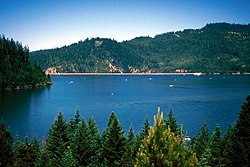Lost Creek Lake
| Lost Creek Lake | |
|---|---|

The lake behind William L. Jess Dam
|
|
| Location | Jackson County, Oregon |
| Coordinates | 42°40′59″N 122°39′17″W / 42.68306°N 122.65472°WCoordinates: 42°40′59″N 122°39′17″W / 42.68306°N 122.65472°W |
| Type | reservoir |
| Primary inflows | Rogue River |
| Primary outflows | Rogue River |
| Catchment area | 674 sq mi (1,750 km2) |
| Basin countries | United States |
| Max. length | 10 mi (16 km) |
| Surface area | 3,430 acres (13.9 km2) (full pool) |
| Water volume | 315,000 acre·ft (389×106 m3) |
| Shore length1 | 30 mi (48 km) |
| Surface elevation | 1,751 to 1,872 ft (534 to 571 m) |
| 1 Shore length is not a well-defined measure. | |
Lost Creek Lake is a reservoir located on the Rogue River in Jackson County, Oregon, United States. The lake is impounded by William L. Jess Dam which was constructed by the U.S. Army Corps of Engineers in 1977 for flood control and fisheries enhancement. The lake and dam were the first completed elements of the multi-purpose Rogue River Basin Project, consisting of Lost Creek Lake, Applegate Lake and the Elk Creek project. The lake is located approximately 27 miles (43 km) (straight line) northeast of Medford.
Construction of Lost Creek Dam began in 1972 and was completed in 1977. In 1996, the Congress renamed Lost Creek Dam, along with the adjoining intake structure, in honor of William L. Jess, one of the founders of the Rogue Basin Association, which was established in 1955. Jess was a strong advocate for the construction and multiple use of the impounded waters.
The primary purpose of the dam is flood control and is operated in conjunction with Applegate Dam to regulate water flows down the river as well as to impound water for summer use. The dam is an earthfill structure with a gated spillway and contains two hydroelectric generating units with a total capacity of 49 megawatts. The hydroelectric plant has a rated flow capacity of 2,600 cubic feet per second (74 m3/s). The technologically advanced and unusual intake tower regulates water temperature by combining lake water from different depths in a mixing chamber before releasing it downstream. This serves to cool the normally warm summer water of the Rogue River, which improves conditions for fish migration and survival. The dam is 3,750 feet (1,140 m) long, 327 feet (100 m) high, with the top of the dam at an elevation of 1,882 feet (574 m) above mean sea level (MSL).The river below the dam is a popular area for easy rafting and tubing in the summer when the water is relatively warm. Joseph H. Stewart State Recreation Area is located along the southern shore of the lake. Casey State Park is located on the Rogue River below the dam.
...
Wikipedia
